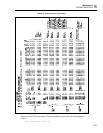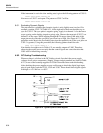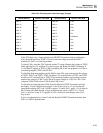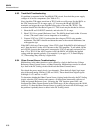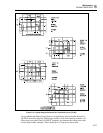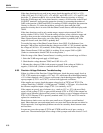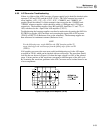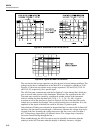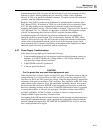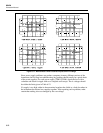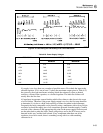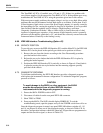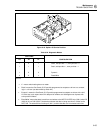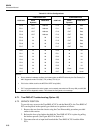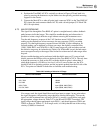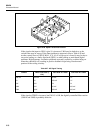
Maintenance
TROUBLESHOOTING
6
6-61
problem between the A/D Converter and the In-Guard µC can cause erroneous or noisy
readings or offsets. Similar problems may be caused by a failure of the Calibration
Memory (U220) or by bad A/D calibration constants. (To check for bad A/D calibration
constants, clear the calibration memory.)
Readings at the A/D Converter can be determined by interpreting the waveform at the
DAC output (TP102). Waveforms at TP102 for several input levels are shown in Figure
6-18. The A/D reading can be calculated by knowing the weight of each bit and by
weighting each nibble correctly. (The first nibble is weighted 1, the second 1/16, the third
1/16
2
the fourth 1/16
3
etc.) Figure 6-18 shows how to read the A/D output for an input
of 0.66V by interpreting the waveform at TP102 using the first three nibbles.
Troubleshooting the A/D Converter for defective components can be simplified by
setting the circuit in a quiescent state. This can be done by selecting EX TRIG, which
causes all A/D activity to stop. The A/D Converter is then in the autozero configuration,
and the offset of the amplifiers and the various levels in the bootstrap circuits can be
easily measured with a voltmeter. Oscillations at the outputs of the amplifiers and other
abnormal signals can easily be identified with an oscilloscope.
6-67. Power Supply Troubleshooting
If the display does not light up, first check the following:
1. Is the instrument plugged in to an energized outlet providing alternating current at a
frequency of 47 Hz to 440 Hz and a voltage within +/-10% of that selected by the
rear panel line voltage selection switches?
2. Is the POWER switch ON (pushed in)?
3. Is the rear panel fuse blown?
CAUTION
For fire protection, use exact fuse replacement only.
If the rear panel fuse is blown, replace it with a 250V fuse of the proper rating for the line
voltage selected. Use 1/4A slow-blow for 100V and 120V power-line voltage and 1/8A
slow-blow for 200V and 240V power-line voltage. If the fuse keeps blowing, measure the
resistances of the power transformer (T601) windings. They should be within 10% of the
values shown on the schematic. If not, the transformer is probably shorted. Also inspect
the area around the transformer POWER switch and power-cord connector to make sure
there isn’t something shorting out the traces. If the IEEE-488 Interface board is suspected
of causing the problem, it can easily be unplugged. Check the crowbar circuit (CR615
and Q601, and R605). If CR615 or Q601 is shorted or if there is a large amount of
leakage or R605 is open, fuses may continue to blow.
If everything looks OK but the fuse keeps blowing, troubleshooting may be performed by
powering the instrument through a variac, applying only enough line voltage to find the
problem without blowing the fuse. NEVER USE A LARGER FUSE. To do so will only
turn a small problem into a big one.



